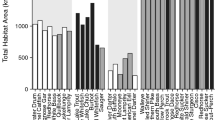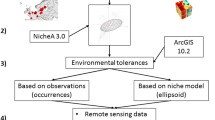Abstract
Introduced species are a major threat to the planet’s ecosystems and one of the major causes of species extinction. This study deals with some of the economic impacts of one of these “invaders,” variable milfoil. Variable milfoil can clog waterbodies, cause boating and swimming hazards, and crowd out native species. This study analyzed the effects of variable milfoil on shoreline property values at selected New Hampshire lakes. Results indicate that property values on lakes experiencing milfoil infestation may be considerably lower than similar properties on uninfested lakes. Results are highly sensitive to specification (variable selection) of the hedonic equation.
Similar content being viewed by others
Notes
In the literature, terms such as “nonnative,” “nonindigenous,” “alien,” “exotic,” and “invasive” are often used interchangeably to describe (usually human) introduced species. In this article, the term nonnative will be used as a general term for consistency.
Throughout this article, the term milfoil will be used to refer specifically to variable milfoil.
While most of the information cited in this section is from New Hampshire sources, similar discussions can be found in many of the states dealing with milfoil, which range from Maine to North Dakota. A recent web search found over 2000 entries on variable milfoil, most dealing with individual lake issues.
The specific time period (1990–1995) was initially chosen for consistency with two studies previously done at the University of Maine, so that a pooled data set could later be used to generate second stage hedonic estimates (Michael and others 1996).
The ten lakes are Crystal, Halfmoon, Lee, MerryMeeting, Squam, Suncook, Waukewan, Wicwas, Winnesquam, and Winona.
Model formulations that included a separate value for lake size (LKA) resulted in effects of milfoil ranging from decline of over 50% of property value (linear model) to about a 22% decline in values in the log-linear form (although the milfoil variable was not significant at the 10% level in this model).
Thanks to an anonymous reviewer for this suggestion.
References
N. W. Bouwes R. Schneider (1979) ArticleTitleProcedures in estimating benefits of water quality change. American Journal of Agricultural Economics 61 535–539
G. M. Brown H. Pollakowski (1977) ArticleTitleEconomic valuation of shoreline. Review of Economics and Statistics 59 272–278
K. P. Boyle J. Poor L. O. Taylor (1999) ArticleTitleEstimating the demand for protecting freshwater lakes from eutrophication. American Journal of Agricultural Economics 81(5) 1119–1122
M. Cropper L. B. Deck K. E. McConnell (1988) ArticleTitleOn the choice of functional form for hedonic price functions. Review of Economics and Statistics 70(4) 668–675
D. Epp K. S. Al-Ani (1979) ArticleTitleThe effect of water quality on rural nonfarm residential property values. American Economic Review August 529–534
A. Freeman (1974) ArticleTitleOn estimating air pollution control benefits from land value studies. Journal of Environmental Economics and Management 9(1) 74–83
A. M. Freeman (1979) The benefits of environmental improvement: Theory and practice John Hopkins University Press, Resources for the Future Baltimore
A. M. Freeman (1993) Property value models. Measurement of environmental and resource values Resources for the Future Washington DC
G. D. Garrod K. G. Willis (1992) ArticleTitleValuing goods’ characteristics: An application of hedonic price method to environmental attributes. Journal of Environmental Management 34 59–76 Occurrence Handle1:STN:280:ByyA2sfmvFw%3D Occurrence Handle7764000
J. P. Gibbs J. M. Halstead K. J. Boyle J. -C. Huang (2002) ArticleTitleAn hedonic analysis of the effects of lake water clarity on New Hampshire lakefront properties. Agricultural and Resource Economics Review 31(1) 39–46
P. Graves G. C. Murdoch M. A. Thayer D. Waldman (1988) ArticleTitleThe robustness of hedonic price equations: Urban air quality. Land Economics 64(3) 220–233
J. M. Halstead R. A. Bouvier B. E. Hansen (1997) ArticleTitleOn the issue of functional form choice in hedonic price functions: Further evidence. Environmental Management 21(5) 759–765 Occurrence Handle10.1007/s002679900065
K. J. Lancaster (1966) ArticleTitleA new approach to consumer theory. Journal of Political Economy 124(2) 132–157
C. G. Leggett N. E. Bockstael (2000) ArticleTitleEvidence of the Effects of Water Quality on Residential Land prices. Journal of Environmental Economics and Management 39(2) 121–144 Occurrence Handle10.1006/jeem.1999.1096
McNeely, J. A., K. R. Miller, W. V. Reid, R. A. Mittermeier, and T. B. Werner. 1990. Conserving the world’s biological diversity. IUCN, Gland, Switzerland; WRI, CI, WWF-US, and the World Bank, Washington, DC
R. Mendelsohn (1984) ArticleTitleEstimating the structural equations of implicit markets and household production functions. Review of Economics and Statistics 66(4) 673–677
Michael, H. J., K. Boyle, and R. Bouchard. 1996. Water quality affects property prices: A case study of selected Maine lakes. Maine Agricultural and Forest Experiment Station, University of Maine, Miscellaneous Report 398
H. J. Michaels K. Boyle R. Bouchard (2000) ArticleTitleDoes the measurement of environmental quality affect implicit prices estimated from hedonic models? Land Economics 76(2) 283–298
G. Michaels V. K. Smith (1990) ArticleTitleMarket segmentation and valuing amenities with hedonic models: The case of hazardous waste sites. Journal of Urban Economics 28 223–242
J. W. Milon J. Gressel D. Mulkey (1984) ArticleTitleHedonic amenity valuation and functional form specification. Land Economics 60(4) 378–387
Morse, L. E., J. T. Kartesz, and L. S. Kutner. 1995. Native vascular plants. In E. T. LaRoe, G. S. Farris, C. E. Puckett, P. D. Doran, and M. J. Mac (eds), Our living resources: A report to the nation on the distribution, abundance, and health of US plants, animals, and ecosystems. US Department of the Interior, National Biological Service, Washington, DC
Motavalli, J. 2001. Here comes trouble: Facing up to the invasive-species onslaught. Appalachian Mountain Club. Outdoors 15
J. Murdoch M. Thayer (1992) ArticleTitleHedonic price estimation of variable urban air quality. Journal of Environmental Economics 15(2) 143–146
NH-DES (New Hampshire Department of Environmental Services). 1999. Exotic aquatic weed control program: Chronology of events, 1981–1996. Concord, New Hampshire
NH-DES (New Hampshire Department of Environmental Services). 2000. Weed watcher kit 2000. Concord, New Hampshire
J. P. Nelson (1978) ArticleTitleResidential choice, hedonic prices, and the demand for urban air quality. Journal of Urban Economics 5 357–369
(OTA) Office of Technology Assessment. 1993. Harmful non-indigenous species in the United States. Office of Technology Assessment, US Congress, Washington, DC
D. Pimentel (2002) Biological invasions: Economic and environmental costs of alien plant, animal, and microbe species. CRC Press New York
D. Pimentel L. Lach R. Zuniga D. Morrison (1999) Environmental and economic costs associated with non-indigenous species in the United States. Cornell University, College of Agriculture and Life Sciences Ithaca, New York
S. Rosen (1974) ArticleTitleHedonic prices and implicit markets: Product differentiation in pure competition. Journal of Political Economy 81(1) 34–55 Occurrence Handle10.1016/S0024-4937(98)00078-4 Occurrence Handle1:CAS:528:DyaK1MXhslOnurc%3D
Simberloff, D. 1996. Impacts of introduced species in the United States. Consequences The Nature and Implications of Environmental Change 2(2):000
R. L. Smith (1996) Ecology and field biology HarperCollins New York
E. Wilman (1984) External costs of coastal beach pollution: An hedonic approach. Resources for the Future Washington, DC
Acknowledgments
The authors would like to thank Ju-Chin Huang and two anonymous reviewers for helpful comments. Thanks also for support from the New Hampshire Department of Environmental Services and Amy Smagula. Any remaining errors are those of the authors.
Author information
Authors and Affiliations
Corresponding author
Rights and permissions
About this article
Cite this article
Halstead, J., Michaud, J., Hallas-Burt, S. et al. Hedonic Analysis of Effects of a Nonnative Invader (Myriophyllum heterophyllum) on New Hampshire (USA) Lakefront Properties . Environmental Management 32, 391–398 (2003). https://doi.org/10.1007/s00267-003-3023-5
Published:
Issue Date:
DOI: https://doi.org/10.1007/s00267-003-3023-5




